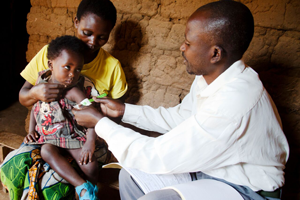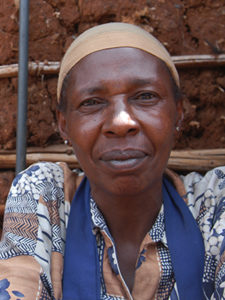Before designing any SBCC intervention, it is important to analyze the intended audience to gain a better understanding of who they are, including their current behaviors, and to decide which sub-segment or "primary audience" you will address.
This same process is used when designing an intervention to improve CHW behavior. CHWs are similar to other audiences identified for SBCC in that they have their own unique sets of needs, desires, biases and attitudes that need to be understood in order to identify SBCC solutions. The Audience Analysis is an important step in understanding CHWs as an audience.
The following are the key steps to audience analysis:
1 Review Audience Information
Review what you collected in the situation analysis (either through the Performance Needs Assessment or the Secondary Data Analysis) to understand:
- Current levels of performance
- Key barriers to quality service provision by category (Expectation, Ability, Opportunity and Motivation)
- Total number of providers, geographic location and services provided
- Socio-demographic characteristics like age, years of experience, education level and religion
- Beliefs, attitudes, knowledge levels and current behaviors
- Psychographic data like CHWs’ needs, aspirations, hopes, fears and habits
- Other information as appropriate
Additional audience research may need to be gathered. See the Audience Analysis and Formative Research how-to guides for more guidance.
2 Decide Whether to Segment
 Audience segmentation is the process of dividing the larger CHW audience into smaller groups or "segments" of similar individuals. Segmentation is important because different people respond differently to SBCC messages and interventions. It helps program teams better channel resources and narrow the focus on a "primary audience." For programs working with providers, segmentation also helps to better target monitoring, coaching and routine support supervision activities. If after the review of audience information it is determined that smaller groups with similar behaviors, needs, values and/or characteristics (segments) exist within the larger audience, it is best to segment.
Audience segmentation is the process of dividing the larger CHW audience into smaller groups or "segments" of similar individuals. Segmentation is important because different people respond differently to SBCC messages and interventions. It helps program teams better channel resources and narrow the focus on a "primary audience." For programs working with providers, segmentation also helps to better target monitoring, coaching and routine support supervision activities. If after the review of audience information it is determined that smaller groups with similar behaviors, needs, values and/or characteristics (segments) exist within the larger audience, it is best to segment.
One Method to Segment Providers – Population Services International
Population Services International (PSI) uses a method, adapted from the commercial pharmaceutical sector, to determine whether it is necessary to segment health providers before introducing a performance improvement approach. The approach uses two primary criteria: 1) Is there potential for health impact (i.e., are the providers working in a region or with clients who have a need for health improvement)? and 2) Are the providers currently providing services or performing the desired behavior? Using these criteria, the segments are categorized in a Provider Segmentation Matrix:
| Behaviors | |
|---|---|
| High Potential/Low Behavior
These providers are working in high density communities heavily populated by members of the intended audience (i.e., women of reproductive age or children under 5), but see very few clients or are not consistently performing the desired behavior. | High Potential/High Behavior
These providers work in high-density communities and see high numbers of clients and are already providing good quality services. They are designated as "stars." |
| Low Potential/High Behavior
These providers have a low client load, perhaps because they are not located in an area where people demand services from CHWs or there is low population density, but they are providing high quality services to the small number of clients they see. | Low Potential/Low Behavior
These providers have a very low client load and, for whatever reason, are not offering services or performing the desired behavior. |
Using this method, PSI determines whether there are distinct segments among the providers and which groups should be prioritized. Prioritized segments are providers who demonstrate both potential to improve health impact – in areas where there is demand for health services that is not already met – and who are not currently performing the desired behavior. This often results in prioritizing providers in the A and B quadrants.
3 Determine Segmentation Criteria
If segmentation is required, look at the audience and identify traits that make one sub-group different from another. A significant difference is one that requires a different message or approach. These distinctions can be categorized by socio-demographic, geographic, behavioral and psychographic. See the table below for unique criteria for CHWs.
| Socio-Demographic | Geographic | Behavioral | Psychographic |
|---|---|---|---|
|
|
|
|
4 Segment the Audience
Segment your audience using criteria identified in Step Three. Consider using a segmentation table, such as the one below:
Download Segmentation Table Template
| Potential Audiences | Potential Primary Audiences | Potential Influencing Audiences |
|---|---|---|
| Demographic Characteristics
Age, gender, years of training and years as CHW | ||
| Geographic Characteristics
Region, urban or rural, and area of conflict | ||
| Socio-Cultural Characteristics
Language, culture, place in society, religion and ethnicity | ||
| Behavioral Characteristics
Behaviors that affect or impact the challenge | ||
| Psychographic Characteristics
Personality, values, attitudes, interests, lifestyle and reasons for wanting to be a CHW | ||
| Ideational Characteristics
May include knowledge, beliefs and attitudes about CHW work, expectations and attitudes about clients served, perceived risk, self-efficacy, social support and influence, environmental supports and constraints, emotions, norms and self-image | ||
5 Assess Proposed Audience Segments
Once segments have been selected, ensure they are valid and usable. Use a checklist to ensure each segment meets the criteria for effective segmentation. If a defined segment does not meet the criteria, it is best to drop it and consider other segments.
Consider using this segmentation analysis checklist to assess audience segments.
| Homogeneous | Yes | What it Means: The members of the audience segment are similar in a relevant way. | Why It is Important: This is the basis of audience segmentation - that the members of each segment are similar in terms of needs, values and/or characteristics. |
| Heterogeneous | Yes | What it Means: Each segment is relatively unique, as compared to the other segments that have been identified. | Why It is Important: This demonstrates that the broader audience has been effectively divided into sets of differing communication needs. |
| Measurable | Yes | What it Means: Data from the situation analysis or other research should indicate the size of the audience segment. | Why It is Important: Measurements allow programs to evaluate whether to focus on a particular element. |
| Substantial | Yes | What it Means: The audience segment is large enough, in terms of potential impact on public health, to warrant the program's attention. | Why It is Important: Programs should have a minimum expectation for the impact of their investment. Therefore, programs should only consider segments that are big enough or important enough to impact public health. |
| Accessible | Yes | What it Means: The audience segment is reachable, particularly in terms of communication and access to products or services needed to address the problem. | Why It is Important: Each segment needs to be able to be reached and communicated with efficiently. |
| Actionable/Practical | Yes | What it Means: The program is able to implement a distinctive set of messages and interventions for each audience segment. | Why It is Important: The program must have the resources and ability to address the segments identified. |
| Responsive | Yes | What it Means: Each audience segment can be expected to respond better to a distinct mix of messages and interventions, rather than a generic offering. | Why It is Important: If the segment will not be more responsive to a distinct approach, then the segment can probably be combined with another similar segment. |
Adapted from Criteria for Market Segmentation
6 Prioritize Audience Segments
Deciding which segments to prioritize and how to approach them is critical. If the program team identified more audience segments than it can or needs to reach, narrow the list and finalize which segments the program will focus on. Ultimately, the decision about which segments to prioritize is based heavily on available resources and program goals. Some questions to consider when prioritizing audience segments are:
- How much does this segment impact the overall program objectives?
- How easy are they to reach?
- Do they have significantly different views about their work than their peers?
- How ready are they for behavior change?
- What stage in the behavior change process are they currently in?
More details on How to Do Audience Segmentation.
7 Create CHW Audience Profiles
An audience profile will help you to obtain a more personal sense of the people to be reached through your SBCC efforts. Focus first on the primary audience and think about what you know about them. Then draw an outline of a person who is a typical member of this audience and write a brief description of a single person as a composite of the group.
This profile could describe the CHW’s geographic location, gender, age, cadre, years/level of training, concerns, current behaviors, years of service, where she gets information, what motivates her to be a CHW, current performance, beliefs, values or family situation.
Include findings from the performance assessment such as: the identified barriers and facilitators to improved performance considering the performance factors (Expectation, Opportunity, Ability and Motivation) and anything you know about specific motivational factors to perform well.
You might write “a day in the life” of the provider as a way to capture what is most important to the individual and to better understand their day-to-day experience as a CHW. This profile should be based on data including that gathered during the situation analysis and the performance gap assessment.
Remember: Audience profiles are needed for each prioritized audience segment.
NOTE: If you have determined that CHW motivation is heavily influenced by people at multiple levels (health system, community, organization, family and peers), identify which sub-group(s) are the most critical secondary (influencing) audience(s) and develop a profile for them as well.
Record your selected audiences, audience segments, and audience profiles in the Step 3 section of the SBCC Strategy Template.
Resources
- Designing a Social and Behavior Change Communication Strategy
- PSI Coaching Toolkit
- How to Conduct an Audience Analysis
- How to Do Audience Segmentation
Sample CHW Profile
Name: Halyman
Location: Works in a rural area outside the capital city.
Type: Voluntary Community Health Worker working part time, she has been a CHW for 11 years.
Incentives: She sometimes receives small gifts from the families she serves, such as bus fare.
Education: She has a primary school education.
Family Life: She is married with three children.
Services Provided: She has 260 eligible families in her community and she tries to see five families per day. She provides family planning counseling. She is not allowed to dispense IUDs or any family planning methods but can counsel and provide referrals to the local health clinic located less than half a kilometer from her home. She also provides basic information for child health including nutrition.
Why She Is a CHW: She wants to help people in her community. She is motivated by the satisfaction she feels when people in her community tell her she was a big help to their family.



No Comments